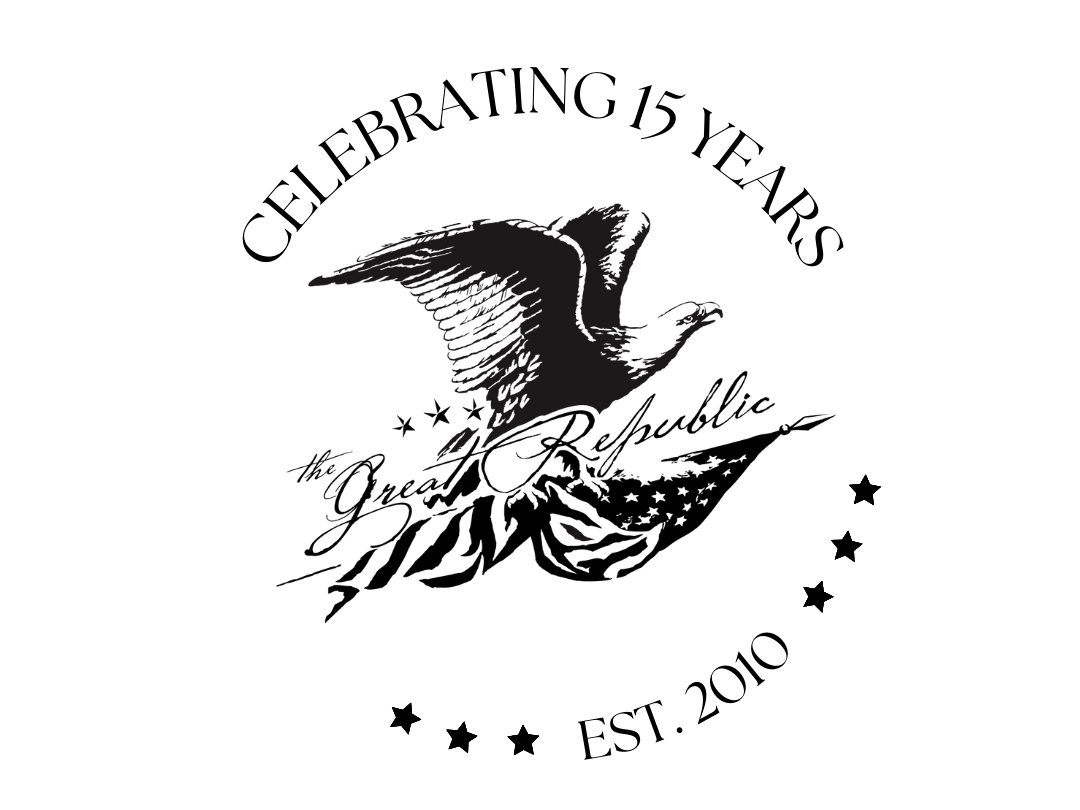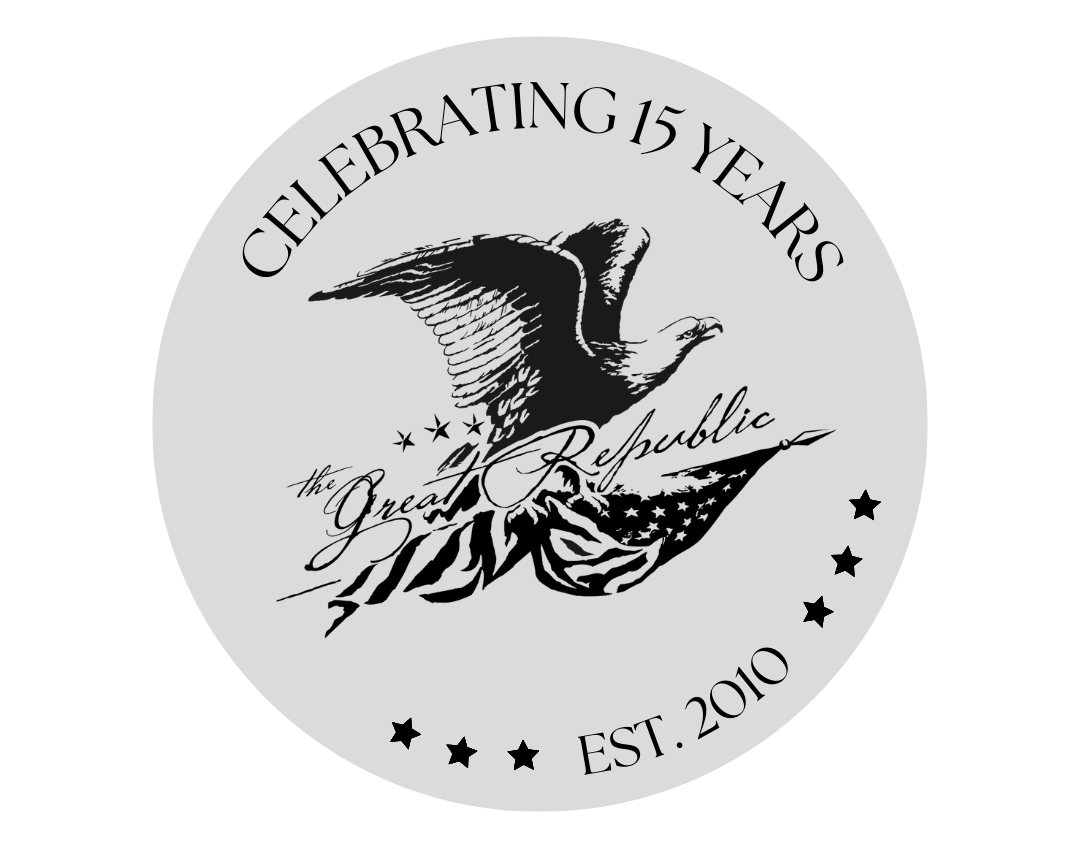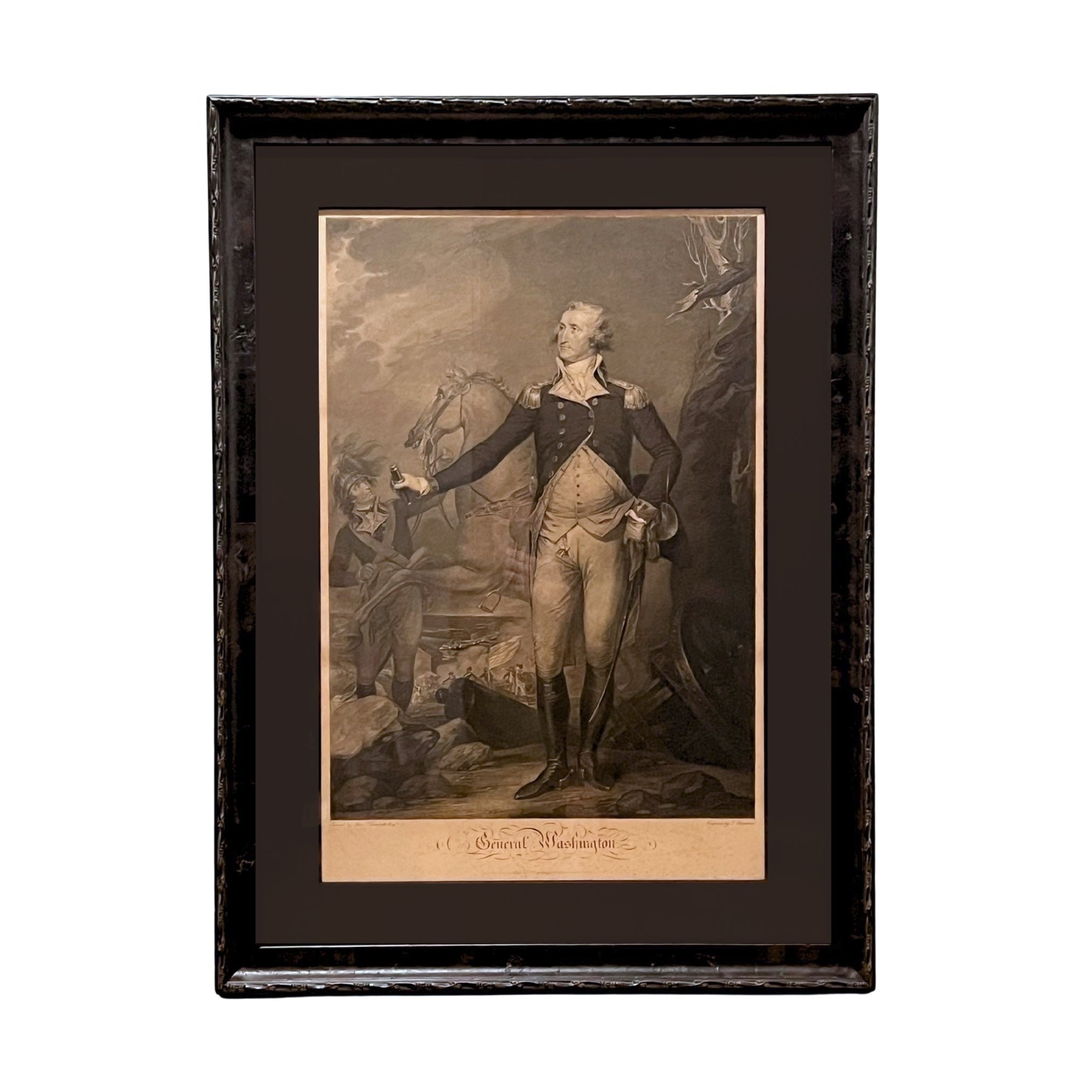
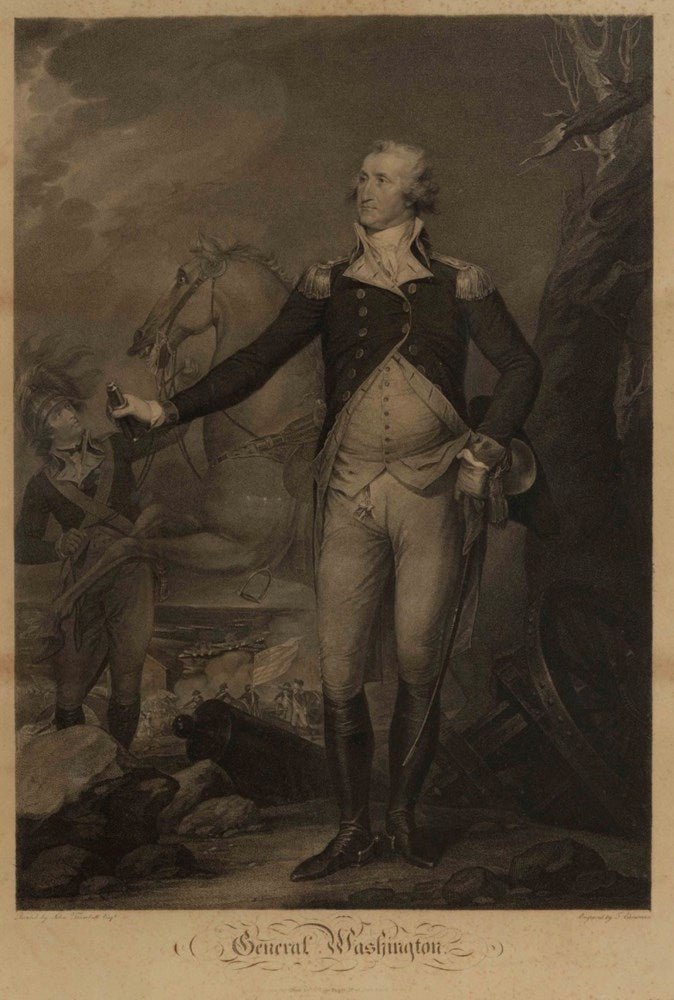
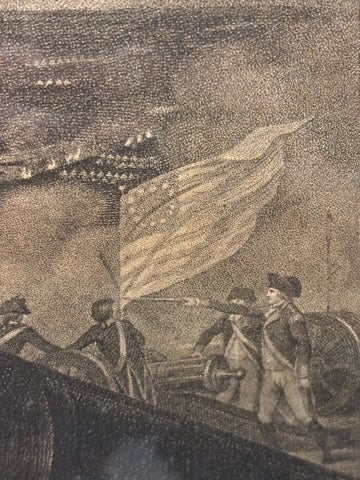
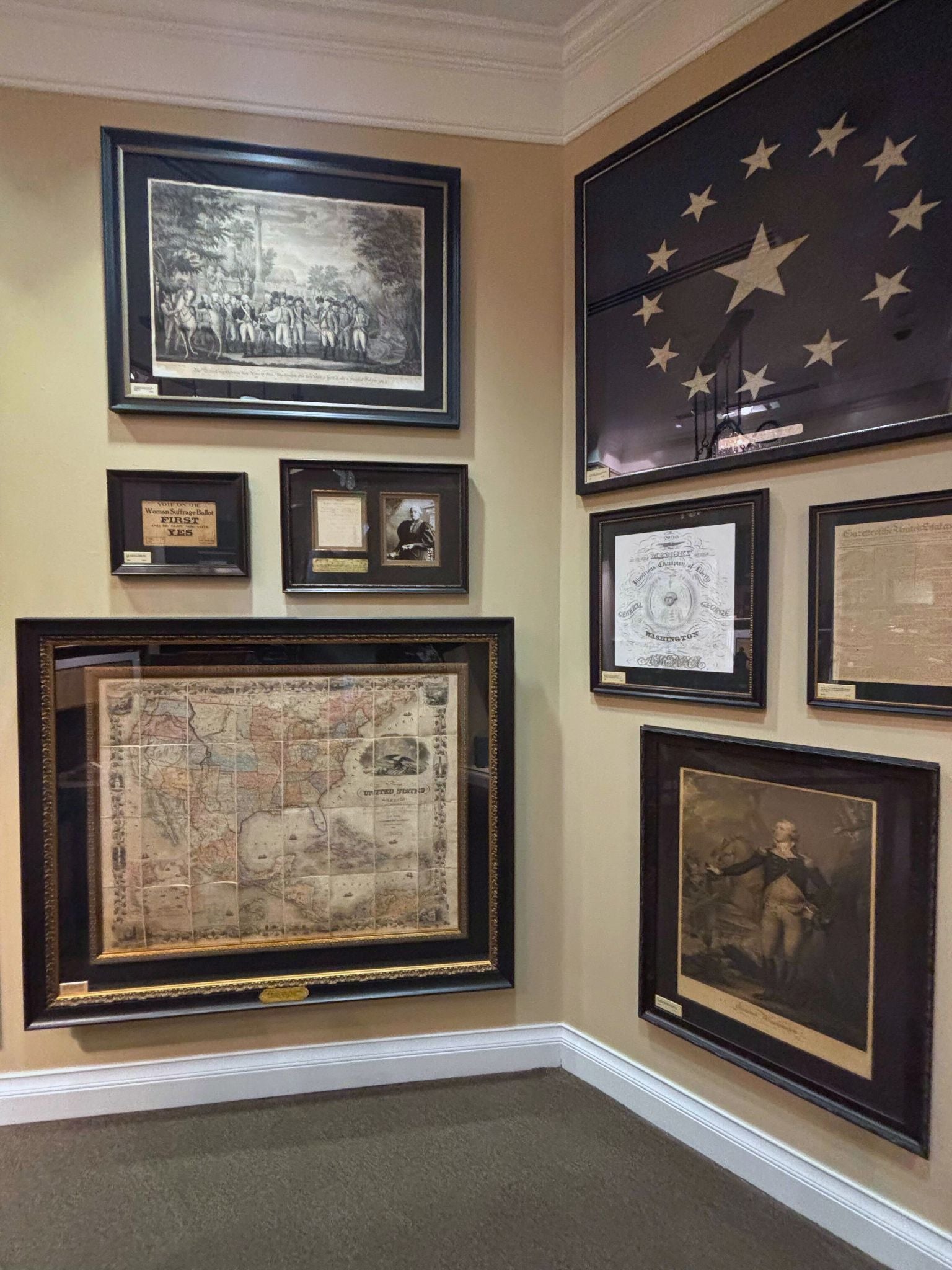
"General Washington" by Thomas Cheesman, after John Trumbull, 1796
Presented is a stipple engraving depicting General George Washington on the night of January 2nd, 1777, just after the Battle of the Assunpink Creek and before the decisive Battle of Princeton. The print was engraved by Thomas Cheesman, after the heroic 1792 painting by John Trumbull, "General Washington at Trenton." The engraving was published by Antonio Cesare Poggi in London, in 1796.
In the composition, Washington stands in front of the battlefield. In his left hand is his sword, and in his right hand is a spyglass. Just behind him, a soldier tends to his white horse Blueskin, while in the background soldiers wave a flag along the icy banks of New Jersey. Also depicted is the bridge over the Assunpink Creek and nearby mill, artillery, and campfires. This is a powerful lifetime portrait of our first President as the courageous and valiant Revolutionary War General.
In 1792, the city of Charleston, South Carolina commissioned the artist John Trumbull to paint a portrait of George Washington, as a commemoration of President Washington's visit to the city in May 1791 during his Southern Tour. Trumbull’s aim was to render Washington and his military character at “the most sublime moment of its exertion — the evening previous to the battle of Princeton, when viewing the vast superiority of his approaching enemy, and the impossibility of again crossing the Delaware, or retreating down the river, [when] he conceives the plan of returning by a night march into the country from which he had just been driven, thus cutting off the enemy's communication, and destroying his depot of stores and provisions at Brunswick.” In order to complete the painting, Washington sat for Trumbull and “talked of the scene, its dangers, its almost desperation… the high resolve to conquer or to perish.” The resulting painting, "General George Washington at Trenton,” was ultimately rejected by the city of Charleston, since it did not meet the city's desire for a more peaceful and "matter-of-fact" likeness of the President. Trumbull, however, considered it the "best certainly of those which I painted, and the best, in my estimation, which exists, in his heroic military character." (John Trumbull, Autobiography, Reminiscences and Letters of John Trumbull from 1756 to 1841, pg. 166-167).
In 1794, Trumbull traveled to London as secretary of legation for John Jay during the negotiations of the Jay Treaty. During his stay, he executed a small version of his painting and later supervised its engraving by Thomas Cheesman, entitled “George Washington”. The stipple engraving was published by Antoni de Poggi in London in August of 1796. Introduced to de Poggi through his mentor Benjamin West, Trumbull notes meeting "an Italian artist, by the name of Antonio di Poggi, of very superior talents as a draughtsman, and who had recently commenced the business of publishing."
John Trumbull (1756-1843) was perhaps the most important history painter in America during the late 18th and early 19th century. After studying with Benjamin West in London, Trumbull is credited with bringing the grand style of history painting to the United States. His paintings of major episodes in the American Revolution form a unique record of that conflict’s events and participants. And by creating engravings of his paintings, Trumbull spread his conventional heroic pictures to audiences and consumers far beyond those who might see the original painting. Trumbull wrote to John Eliot, “by having prints done… [we] bring them within the powers of our American purses.” The artist popularized the republican tradition of public memory, and in the process he envisioned a nation that encompassed both the reverence of heroes and popular participation. Trumbull wrote, “Historians will do justice to an area so important; but to be read, the language in which they write must be understood – the language of Painting is universal, and intelligible in all nations, and every age.”
British engraver and artist, Thomas Cheesman (1760-1834), was a pupil of Bartolozzi from the mid 1770s. He was awarded a medal by the Society of Arts in London for his engraving of Benjamin West's “The Plague Stayed by the Repentance of David,” painted in 1813.
CONDITION:
Good condition overall, considering age. Stipple engraving, on laid paper. Paper without tears, but with moderate to heavy toning and scattered foxing throughout. Title engraved in bottom margin, along with artist, publisher, and engraver information.
Engraving has been artfully and archivally framed with dark chocolate linen top mat, acid-free bottom mats, coroplast backing, UV plexiglas, and a custom built wooden frame.
Framed dimensions: 36 1/2” H x 27” W x 2” D.
Accompanied by our company’s letter of authenticity.
Pickup available at Colorado
Usually ready in 4 hours

"General Washington" by Thomas Cheesman, after John Trumbull, 1796
Colorado
1 Lake Avenue
Colorado Springs CO 80906
United States
Choose options




Frequently Asked Questions
FAQs
Yes, all of our Antiques are certified authentic. Every antique comes with a signed Letter of Authenticity that details the item’s history, its current condition including any conservation, binding, or framing work, and the item’s provenance. The Letters of Authenticity are priced valuations by our authentication specialists, who assure that items are original and unconditionally guaranteed as genuine for life.
We pack and ship your items from our gallery in Colorado Springs. You may also choose to come pick up your order. Antique items are carefully packed and insured during shipping. The shipping price will be calculated at checkout.
We acquire from a variety of trusted sources all over the world, but mostly through auctions and private collections within the United States. All provenance information will be listed on the Letter of
Authenticity accompanying your purchase.
